A Mid-Term Scheduling Method for Cascade Hydropower Stations to Safeguard Against Continuous Extreme New Energy Fluctuations
Abstract
1. Introduction
2. Methodology
2.1. Extreme Scenario Generation Methods
2.1.1. New Energy Continuous Extreme Quantization
2.1.2. Scenario Generation and Reduction
- Processing historical PV output data to obtain extreme output samples;
- Modeling the probability distribution of the samples using a kernel density function and generating PV output sequences through MC simulation sampling;
- Inserting the extreme sequences into non-extreme sequences to create a scenario set for persistent extreme renewable energy output.
- Initialize the scenario set , where the initial weight of each scenario is .
- Calculate the distance matrix M for all scenarios using the Wasserstein distance. For N scenarios, the size of the distance matrix is N × N, and each element represents the distance between scenarios and .
- Find the smallest value in the distance matrix M, which indicates the highest similarity between scenarios and . Merge these two scenarios into a new one, with the weight equal to the sum of their respective weights, and update the scenario set.
- Repeat Step 3 until the number of scenarios is reduced to the target number N.
2.2. Mid-Term Stochastic Optimization Model
2.2.1. Objective Function
2.2.2. Constraints
- (1)
- The water balance constraints are as follows:
- (2)
- The initial and final water lever limits are as follows:
- (3)
- The water level limits are as follows:
- (4)
- The power generation flow limits are as follows:
- (5)
- The discharge flow limits are as follows:
- (6)
- The transmission channel limits are as follows:
- (7)
- The power output limits are as follows:
- (8)
- The daily power output variation limits are as follows:
- (9)
- The deviation constraint between actual and planned water lever is as follows:
- (10)
- The hydropower generation limits are as follows:
2.2.3. Linearization Method of Nonlinear Constraints
3. Case Study
3.1. Data and Background
3.2. Results Analysis
3.2.1. Continuous Extreme Samples
3.2.2. Generation of Typical Scenarios
3.2.3. Dispatch Results
3.2.4. Model Comparison
3.2.5. Sensitivity Analysis
4. Discussion
5. Conclusions
Author Contributions
Funding
Data Availability Statement
Conflicts of Interest
Abbreviations
| MILP | Mixed-integer linear programming |
| PV | Photovoltaic |
| VRE | Variable renewable energy |
| MC | Monte Carlo |
| LHS | Latin hypercube sampling |
| ARNA | Autoregressive moving average |
| ANNs | Artificial neural networks |
| SVMs | Support vector machines |
| SBR | Synchronized backward reduction |
References
- Tong, D.; Zhang, Q.; Zheng, Y.; Caldeira, K.; Shearer, C.; Hong, C.; Qin, Y.; Davis, S.J. Committed emissions from existing energy infrastructure jeopardize 1.5 °C climate target. Nature 2019, 572, 373–377. [Google Scholar] [CrossRef] [PubMed]
- Osman, A.I.; Nasr, M.; Eltaweil, A.S.; Hosny, M.; Farghali, M.; Al-Fatesh, A.S.; Rooney, D.W.; Abd El-Monaem, E.M. Advances in hydrogen storage materials: Harnessing innovative technology, from machine learning to computational chemistry, for energy storage solutions. Int. J. Hydrogen Energy 2024, 67, 1270–1294. [Google Scholar] [CrossRef]
- Matevosyan, J.; Olsson, M.; Söder, L. Hydropower planning coordinated with wind power in areas with congestion problems for trading on the spot and the regulating market. Electr. Power Syst. Res. 2009, 79, 39–48. [Google Scholar] [CrossRef]
- Huh, S.-Y.; Lee, J.; Shin, J. The economic value of South Korea׳s renewable energy policies (RPS, RFS, and RHO): A contingent valuation study. Renew. Sustain. Energy Rev. 2015, 50, 64–72. [Google Scholar] [CrossRef]
- Omri, A.; Ben Jabeur, S. Climate policies and legislation for renewable energy transition: The roles of financial sector and political institutions. Technol. Forecast. Soc. Change 2024, 203, 123347. [Google Scholar] [CrossRef]
- Shang, Y.; Sang, S.; Tiwari, A.K.; Khan, S.; Zhao, X. Impacts of renewable energy on climate risk: A global perspective for energy transition in a climate adaptation framework. Appl. Energy 2024, 362, 122994. [Google Scholar] [CrossRef]
- Bolan, S.; Padhye, L.P.; Jasemizad, T.; Govarthanan, M.; Karmegam, N.; Wijesekara, H.; Amarasiri, D.; Hou, D.; Zhou, P.; Biswal, B.K.; et al. Impacts of climate change on the fate of contaminants through extreme weather events. Sci. Total Environ. 2024, 909, 168388. [Google Scholar] [CrossRef]
- Li, H.; Ren, Z.; Fan, M.; Li, W.; Xu, Y.; Jiang, Y.; Xia, W. A review of scenario analysis methods in planning and operation of modern power systems: Methodologies, applications, and challenges. Electr. Power Syst. Res. 2022, 205, 107722. [Google Scholar] [CrossRef]
- Panigrahi, R.; Mishra, S.K.; Srivastava, S.C.; Srivastava, A.K.; Schulz, N.N. Grid Integration of Small-Scale Photovoltaic Systems in Secondary Distribution Network—A Review. IEEE Trans. Ind. Appl. 2020, 56, 3178–3195. [Google Scholar] [CrossRef]
- Liu, H.; Wang, C.; Ju, P.; Li, H. A sequentially preventive model enhancing power system resilience against extreme-weather-triggered failures. Renew. Sustain. Energy Rev. 2022, 156, 111945. [Google Scholar] [CrossRef]
- Ren, Y.; Sun, K.; Zhang, K.; Han, Y.; Zhang, H.; Wang, M.; Jing, X.; Mo, J.; Zou, W.; Xing, X. Optimization of the capacity configuration of an abandoned mine pumped storage/wind/photovoltaic integrated system. Appl. Energy 2024, 374, 124089. [Google Scholar] [CrossRef]
- Xiaorong, X.; Ningjia, M.; Wei, L.; Wei, Z.; Peng, X.; Haozhi, L. Functions of Energy Storage in Renewable Energy Dominated Power Systems. Proc. CSEE 2023, 43, 158–169. [Google Scholar] [CrossRef]
- Olabi, A.G.; Onumaegbu, C.; Wilberforce, T.; Ramadan, M.; Abdelkareem, M.A.; Al-Alami, A.H. Critical review of energy storage systems. Energy 2021, 214, 118987. [Google Scholar] [CrossRef]
- Dong, Z.; Zhang, Z.; Huang, M.; Yang, S.; Zhu, J.; Zhang, M.; Chen, D. Research on day-ahead optimal dispatching of virtual power plants considering the coordinated operation of diverse flexible loads and new energy. Energy 2024, 297, 131235. [Google Scholar] [CrossRef]
- Zhou, Y.; Zhu, Y.; Luo, Q.; Wei, Y.; Mei, Y.; Chang, F.-J. Optimizing pumped-storage power station operation for boosting power grid absorbability to renewable energy. Energy Convers. Manag. 2024, 299, 117827. [Google Scholar] [CrossRef]
- Yu, S.; Zhou, S.; Chen, N. Multi-objective optimization of capacity and technology selection for provincial energy storage in China: The effects of peak-shifting and valley-filling. Appl. Energy 2024, 355, 122289. [Google Scholar] [CrossRef]
- Zhao, J.; Feng, X.; Pang, Q.; Fowler, M.; Lian, Y.; Ouyang, M.; Burke, A.F. Battery safety: Machine learning-based prognostics. Prog. Energy Combust. Sci. 2024, 102, 101142. [Google Scholar] [CrossRef]
- Kumar, R.; Lee, D.; Ağbulut, Ü.; Kumar, S.; Thapa, S.; Thakur, A.; Jilte, R.D.; Saleel, C.A.; Shaik, S. Different energy storage techniques: Recent advancements, applications, limitations, and efficient utilization of sustainable energy. J. Therm. Anal. Calorim. 2024, 149, 1895–1933. [Google Scholar] [CrossRef]
- Guo, Y.; Ming, B.; Huang, Q.; Wang, Y.; Zheng, X.; Zhang, W. Risk-averse day-ahead generation scheduling of hydro–wind–photovoltaic complementary systems considering the steady requirement of power delivery. Appl. Energy 2022, 309, 118467. [Google Scholar] [CrossRef]
- Jiang, J.; Ming, B.; Huang, Q.; Chang, J.; Liu, P.; Zhang, W.; Ren, K. Hybrid generation of renewables increases the energy system’s robustness in a changing climate. J. Clean. Prod. 2021, 324, 129205. [Google Scholar] [CrossRef]
- Zhu, F.; Zhong, P.-a.; Xu, B.; Liu, W.; Wang, W.; Sun, Y.; Chen, J.; Li, J. Short-term stochastic optimization of a hydro-wind-photovoltaic hybrid system under multiple uncertainties. Energy Convers. Manag. 2020, 214, 112902. [Google Scholar] [CrossRef]
- Jurasz, J.; Canales, F.A.; Kies, A.; Guezgouz, M.; Beluco, A. A review on the complementarity of renewable energy sources: Concept, metrics, application and future research directions. Sol. Energy 2020, 195, 703–724. [Google Scholar] [CrossRef]
- Ma, C.; Liu, L. Optimal capacity configuration of hydro-wind-PV hybrid system and its coordinative operation rules considering the UHV transmission and reservoir operation requirements. Renew. Energy 2022, 198, 637–653. [Google Scholar] [CrossRef]
- Huang, K.; Luo, P.; Liu, P.; Kim, J.S.; Wang, Y.; Xu, W.; Li, H.; Gong, Y. Improving complementarity of a hybrid renewable energy system to meet load demand by using hydropower regulation ability. Energy 2022, 248, 123535. [Google Scholar] [CrossRef]
- Li, Y.; Wang, R.; Li, Y.; Zhang, M.; Long, C. Wind power forecasting considering data privacy protection: A federated deep reinforcement learning approach. Appl. Energy 2023, 329, 120291. [Google Scholar] [CrossRef]
- Fan, Y.; Liu, W.; Zhu, F.; Wang, S.; Yue, H.; Zeng, Y.; Xu, B.; Zhong, P.-A. Short-term stochastic multi-objective optimization scheduling of wind-solar-hydro hybrid system considering source-load uncertainties. Appl. Energy 2024, 372, 123781. [Google Scholar] [CrossRef]
- Zhang, Z.; Dai, H.; Jiang, D.; Yu, Y. Multi-objective operation rule optimization of wind-solar-hydro hybrid power system based on knowledge graph structure. J. Clean. Prod. 2025, 486, 144514. [Google Scholar] [CrossRef]
- Qiu, L.; He, L.; Lu, H.; Liang, D. Systematic potential analysis on renewable energy centralized co-development at high altitude: A case study in Qinghai-Tibet plateau. Energy Convers. Manag. 2022, 267, 115879. [Google Scholar] [CrossRef]
- Almaraashi, M.; Abdulrahim, M.; Hagras, H. A Life-Long Learning XAI Metaheuristic-Based Type-2 Fuzzy System for Solar Radiation Modeling. IEEE Trans. Fuzzy Syst. 2024, 32, 2102–2115. [Google Scholar] [CrossRef]
- Shen, F.; Zhao, L.; Du, W.; Zhong, W.; Peng, X.; Qian, F. Data-Driven Stochastic Robust Optimization for Industrial Energy System Considering Renewable Energy Penetration. ACS Sustain. Chem. Eng. 2022, 10, 3690–3703. [Google Scholar] [CrossRef]
- Yan, R.; Wang, J.; Huo, S.; Qin, Y.; Zhang, J.; Tang, S.; Wang, Y.; Liu, Y.; Zhou, L. Flexibility improvement and stochastic multi-scenario hybrid optimization for an integrated energy system with high-proportion renewable energy. Energy 2023, 263, 125779. [Google Scholar] [CrossRef]
- Shi, Y.; Wang, H.; Li, C.; Negnevitsky, M.; Wang, X. Stochastic optimization of system configurations and operation of hybrid cascade hydro-wind-photovoltaic with battery for uncertain medium- and long-term load growth. Appl. Energy 2024, 364, 123127. [Google Scholar] [CrossRef]
- Li, J.; Zhou, J.; Chen, B. Review of wind power scenario generation methods for optimal operation of renewable energy systems. Appl. Energy 2020, 280, 115992. [Google Scholar] [CrossRef]
- Lucheroni, C.; Boland, J.; Ragno, C. Scenario generation and probabilistic forecasting analysis of spatio-temporal wind speed series with multivariate autoregressive volatility models. Appl. Energy 2019, 239, 1226–1241. [Google Scholar] [CrossRef]
- Li, J.; Zhu, D. Combination of moment-matching, Cholesky and clustering methods to approximate discrete probability distribution of multiple wind farms. IET Renew. Power Gener. 2016, 10, 1450–1458. [Google Scholar] [CrossRef]
- Ioannou, A.; Fuzuli, G.; Brennan, F.; Yudha, S.W.; Angus, A. Multi-stage stochastic optimization framework for power generation system planning integrating hybrid uncertainty modelling. Energy Econ. 2019, 80, 760–776. [Google Scholar] [CrossRef]
- Ren, Z.; Li, W.; Billinton, R.; Yan, W. Probabilistic Power Flow Analysis Based on the Stochastic Response Surface Method. IEEE Trans. Power Syst. 2016, 31, 2307–2315. [Google Scholar] [CrossRef]
- Al-Duais, F.S.; Al-Sharpi, R.S. A unique Markov chain Monte Carlo method for forecasting wind power utilizing time series model. Alex. Eng. J. 2023, 74, 51–63. [Google Scholar] [CrossRef]
- Chen, J.; Rabiti, C. Synthetic wind speed scenarios generation for probabilistic analysis of hybrid energy systems. Energy 2017, 120, 507–517. [Google Scholar] [CrossRef]
- Jiang, C.; Mao, Y.; Chai, Y.; Yu, M.; Tao, S. Scenario Generation for Wind Power Using Improved Generative Adversarial Networks. IEEE Access 2018, 6, 62193–62203. [Google Scholar] [CrossRef]
- Ding, Z.; Wen, X.; Tan, Q.; Yang, T.; Fang, G.; Lei, X.; Zhang, Y.; Wang, H. A forecast-driven decision-making model for long-term operation of a hydro-wind-photovoltaic hybrid system. Appl. Energy 2021, 291, 119353. [Google Scholar] [CrossRef]
- Li, H.; Liu, P.; Guo, S.; Ming, B.; Cheng, L.; Yang, Z. Long-term complementary operation of a large-scale hydro-photovoltaic hybrid power plant using explicit stochastic optimization. Appl. Energy 2019, 238, 863–875. [Google Scholar] [CrossRef]
- Xu, S.; Liu, P.; Li, X.; Cheng, Q.; Liu, Z. Deriving long-term operating rules of the hydro-wind-PV hybrid energy system considering electricity price. Renew. Energy 2023, 219, 119353. [Google Scholar] [CrossRef]
- Lu, N.; Wang, G.; Su, C.; Ren, Z.; Peng, X.; Sui, Q. Medium- and long-term interval optimal scheduling of cascade hydropower-photovoltaic complementary systems considering multiple uncertainties. Appl. Energy 2024, 353, 122085. [Google Scholar] [CrossRef]
- Zhao, Z.; Yu, Z.; Kang, Y.; Wang, J.; Cheng, C.; Su, H. Hydro-photovoltaic complementary dispatch based on active regulation of cascade hydropower considering multi-transmission channel constraints. Appl. Energy 2025, 377, 124573. [Google Scholar] [CrossRef]
- Fang, Y.; Han, J.; Du, E.; Jiang, H.; Fang, Y.; Zhang, N.; Kang, C. Electric energy system planning considering chronological renewable generation variability and uncertainty. Appl. Energy 2024, 373, 123961. [Google Scholar] [CrossRef]
- Guo, L.; Liu, S.; Xi, L.; Zhang, G.; Liu, Z.; Zeng, Q.; Lü, F.; Wang, Y. Research on the Short-Term Economic Dispatch Method of Power System Involving a Hydropower-Photovoltaic-Pumped Storage Plant. Electronics 2024, 13, 1282. [Google Scholar] [CrossRef]
- Liu, Y.; Zhang, H.; Guo, P.; Wu, S. Short-term complementary scheduling of cascade energy storage systems for wind and solar regulation. J. Energy Storage 2025, 124, 116775. [Google Scholar] [CrossRef]
- Zhang, J.; Cheng, C.; Yu, S.; Su, H. Chance-constrained co-optimization for day-ahead generation and reserve scheduling of cascade hydropower–variable renewable energy hybrid systems. Appl. Energy 2022, 324, 119732. [Google Scholar] [CrossRef]
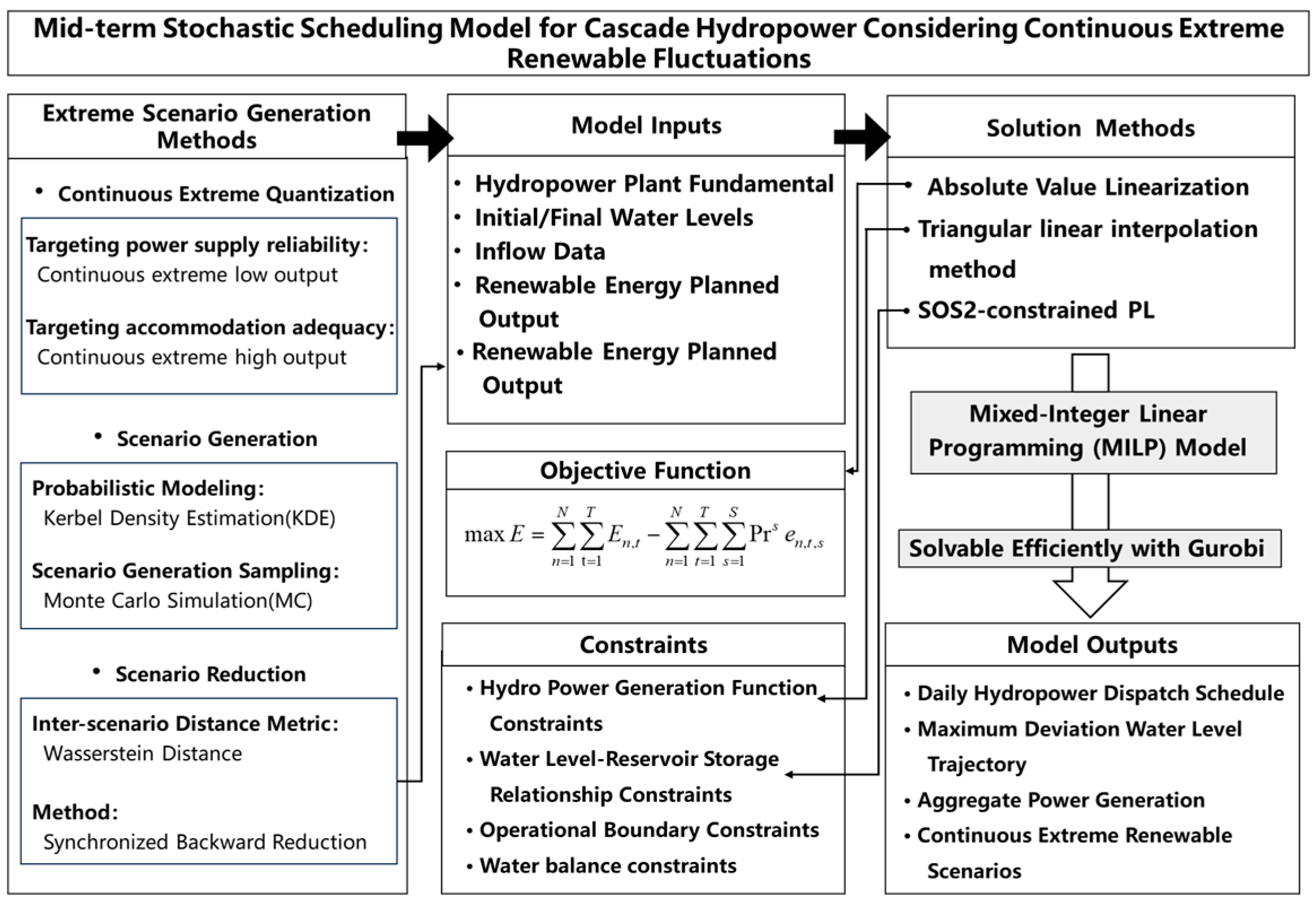
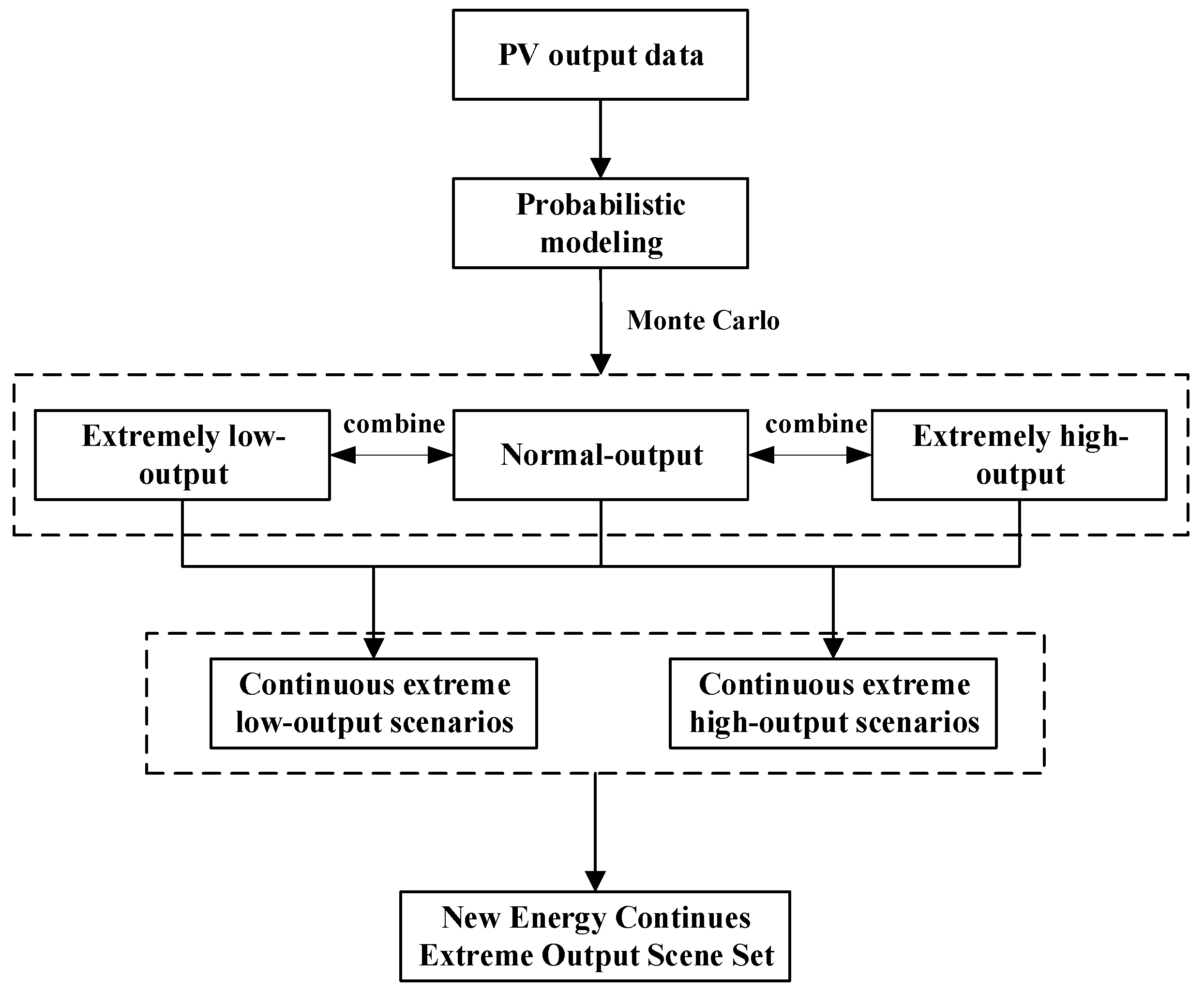
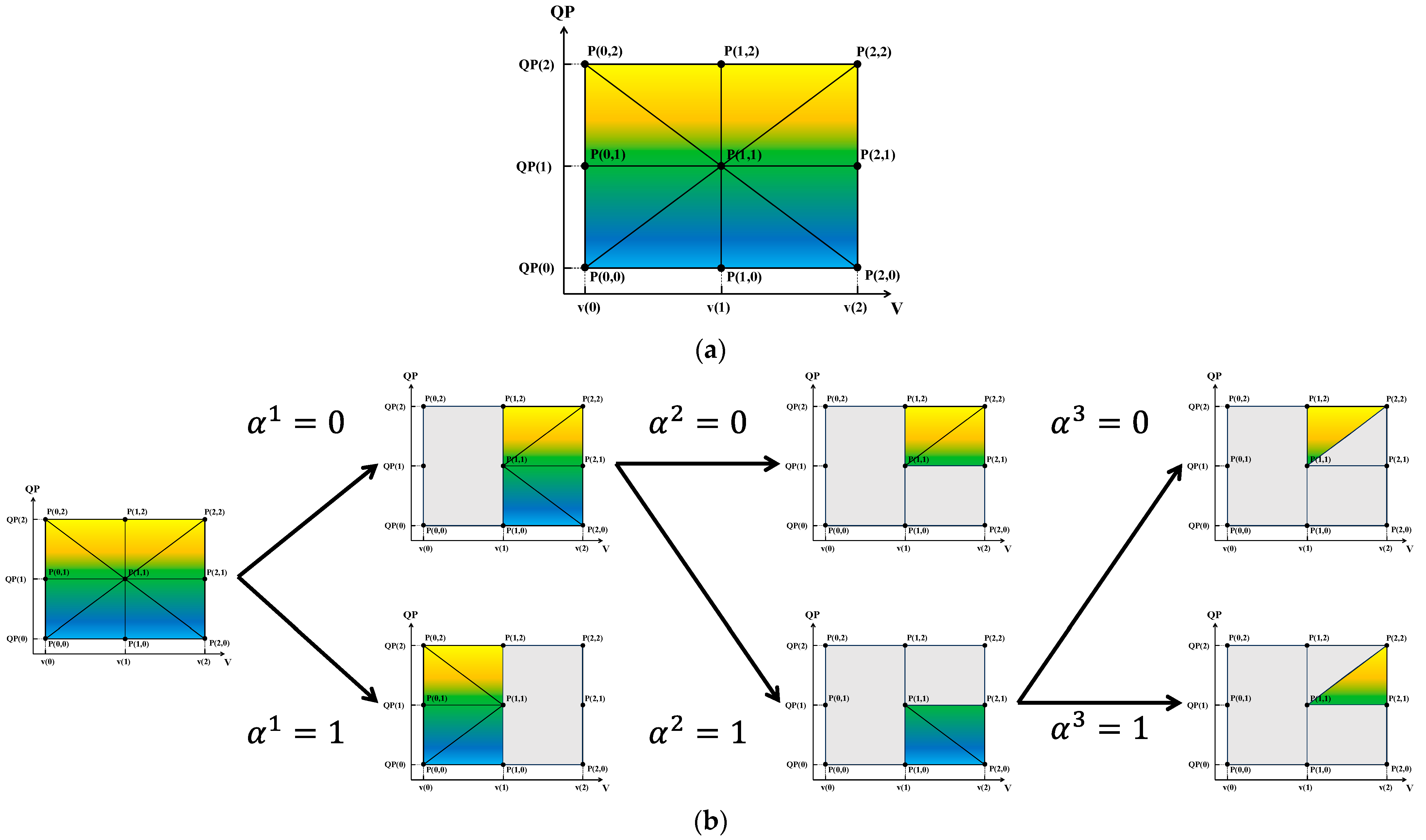
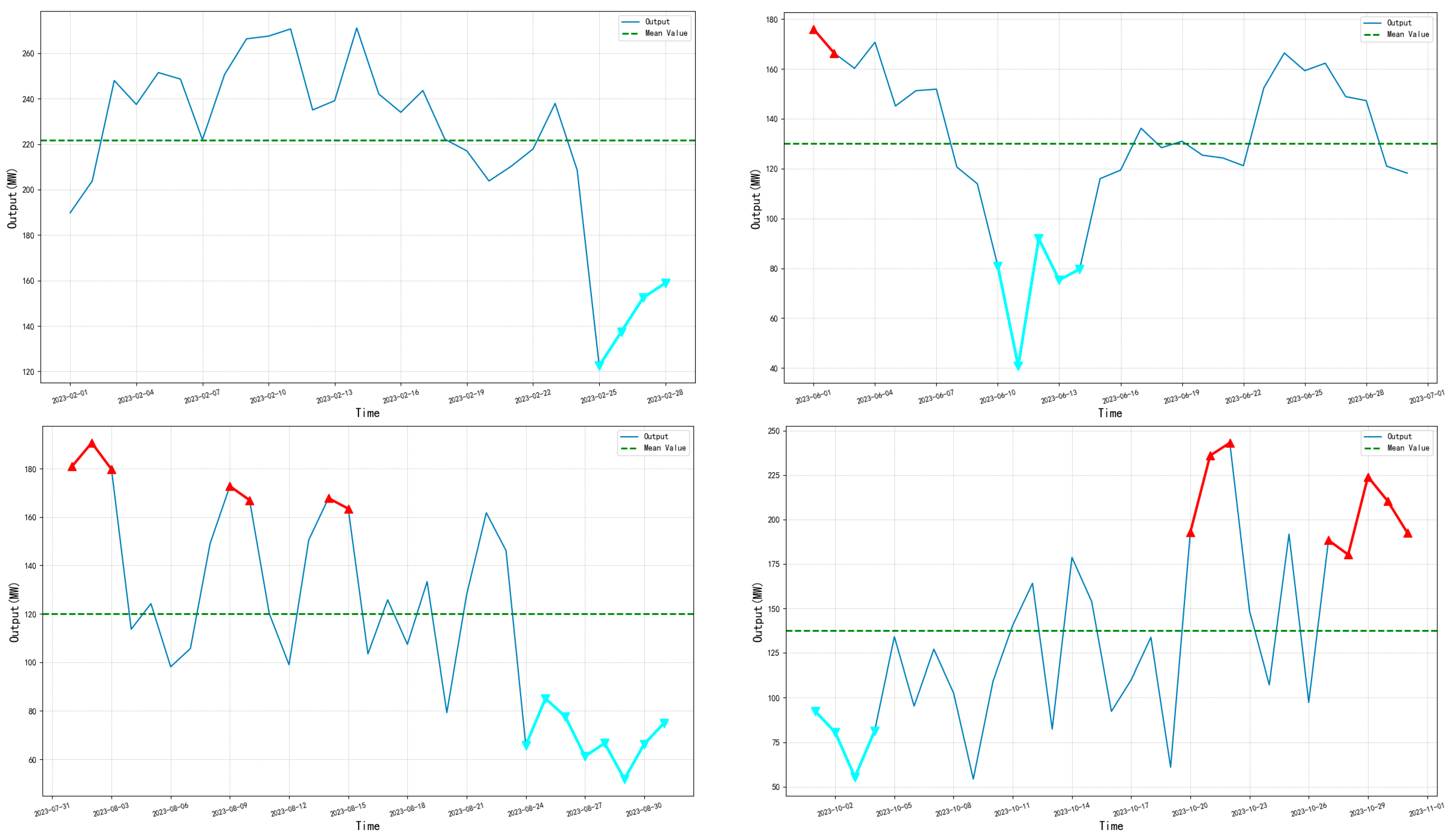
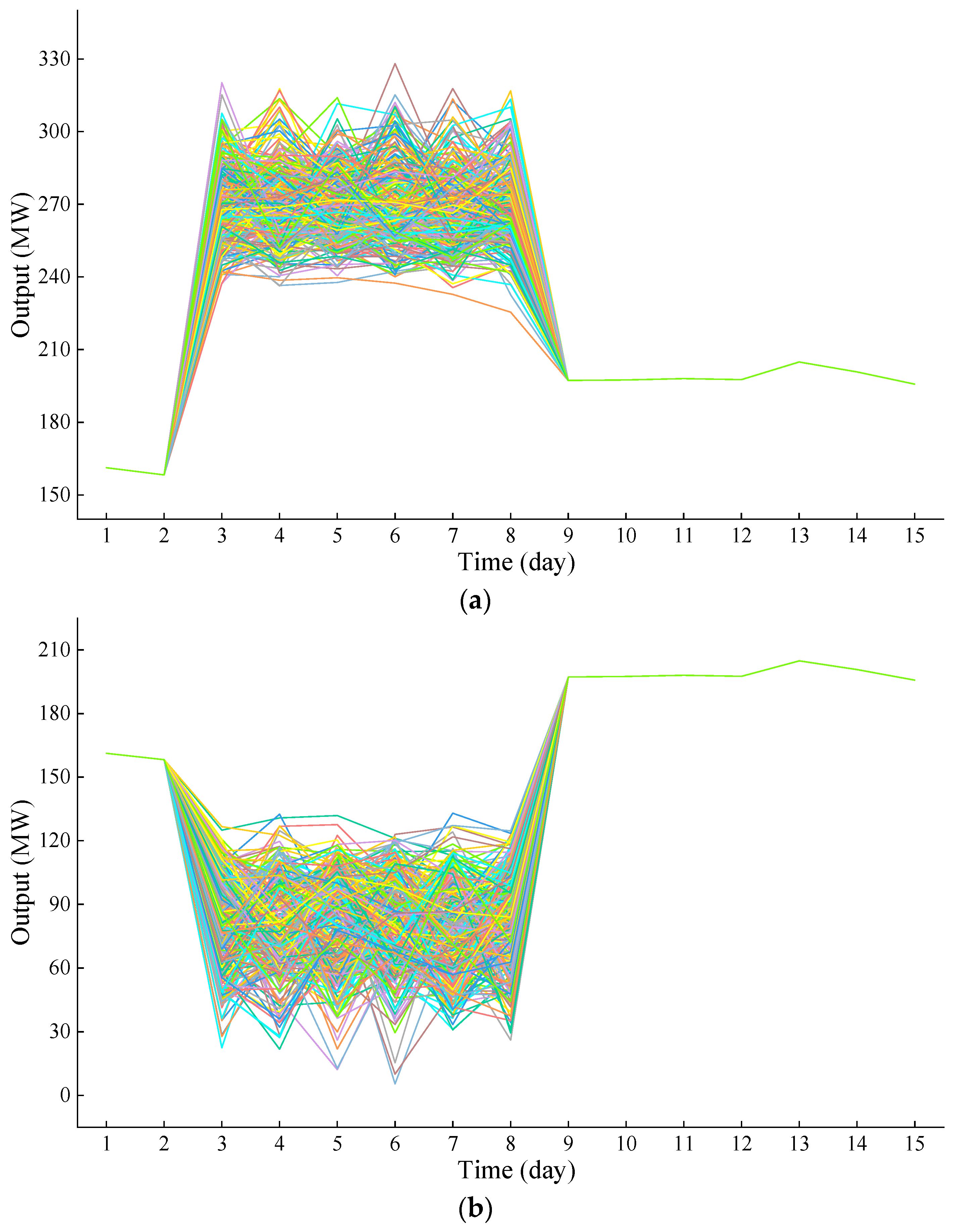
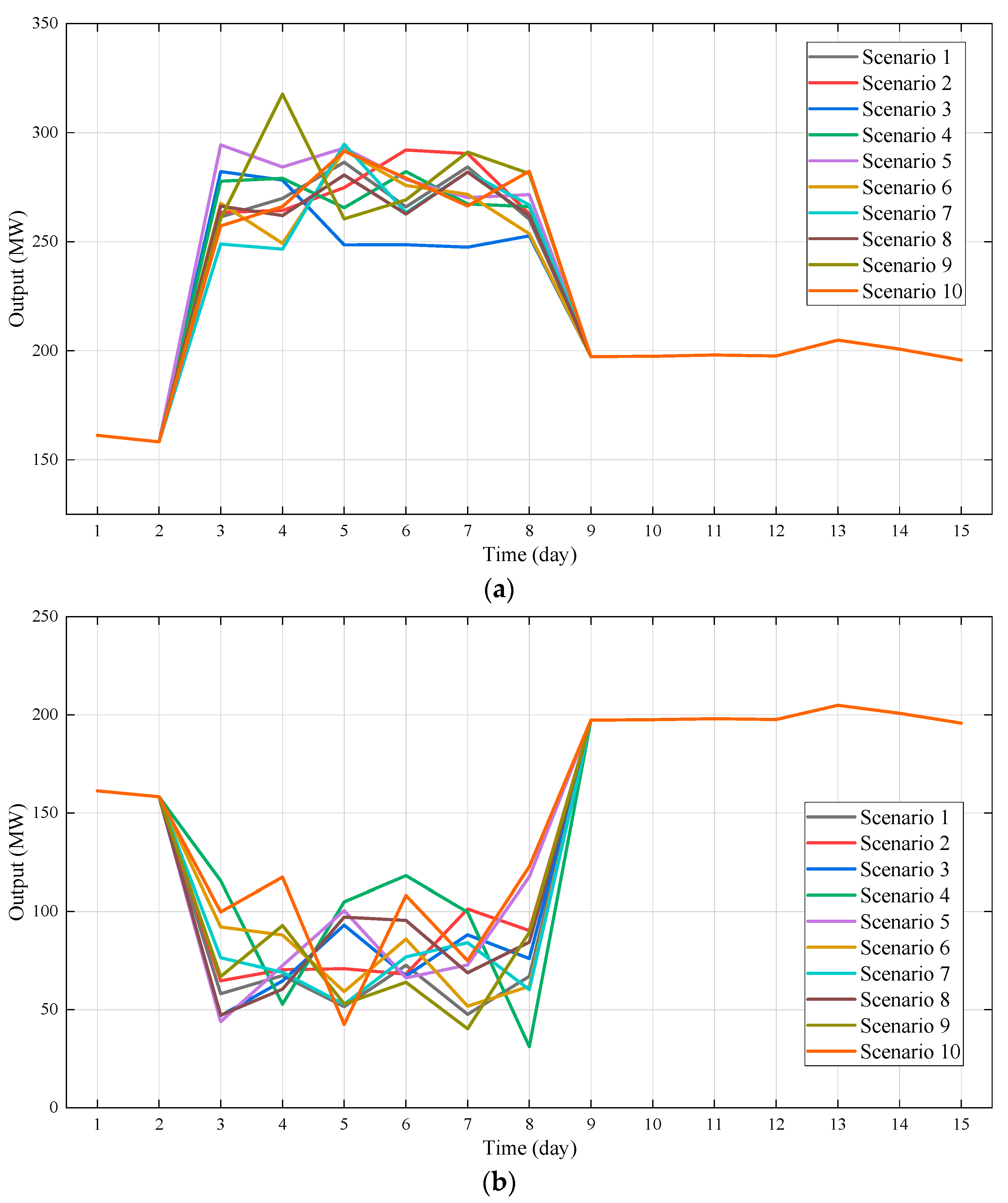
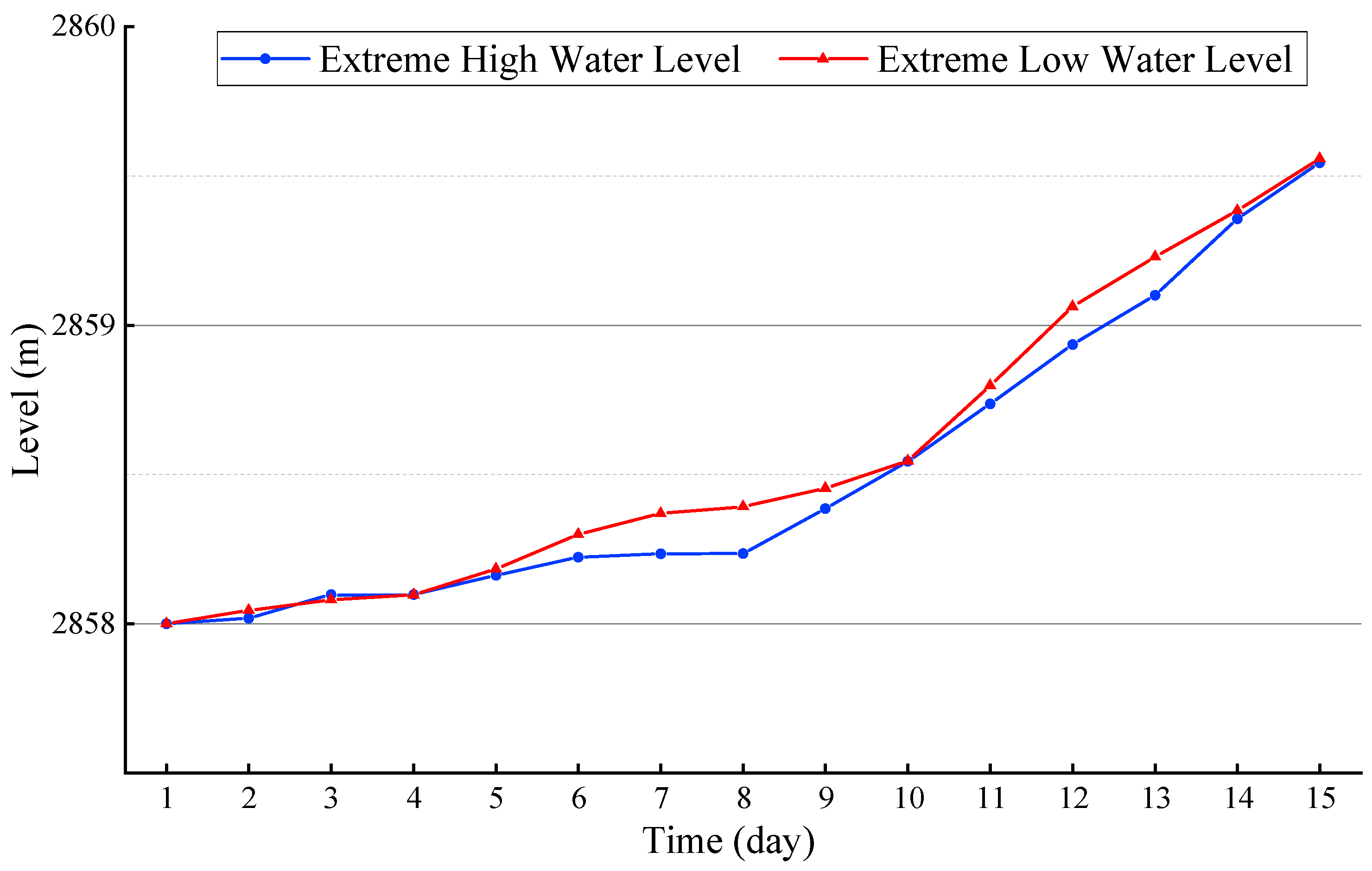


| Indicator | Certainty Model | Model in Paper (High Output) | Model in Paper (Low Output) |
|---|---|---|---|
| Generation | 42.09 × 108 kWh | 42.09 × 108 kWh | 41.24 × 108 kWh |
| Nonpower release | 4.63 × 108 m3 | 4.69 × 108 m3 | 5.14 × 108 m3 |
| Runoff | High PV Output | Low PV Output | Certainty Model | ||||||
|---|---|---|---|---|---|---|---|---|---|
| Output | Spillage | Volatility | Output | Spillage | Volatility | Output | Spillage | Volatility | |
| −40% | 32.91 | 0.57 | 0 | 31.82 | 0 | 0.62 | 32.9 | 0 | 6.76 |
| −30% | 37.36 | 0.59 | 1.66 | 36.43 | 0 | 4.01 | 37.95 | 0 | 9.34 |
| −20% | 40.79 | 1.08 | 19.55 | 39.92 | 0.44 | 17.09 | 41.06 | 0.42 | 30.07 |
| −10% | 41.69 | 2.84 | 6.83 | 41.11 | 2.26 | 11.1 | 41.97 | 2.33 | 30.98 |
| Normal | 42.09 | 5.14 | 13.57 | 41.24 | 4.69 | 8.41 | 42.09 | 4.63 | 13.93 |
| +10% | 41.85 | 7.51 | 13.67 | 40.91 | 6.94 | 11.73 | 41.71 | 6.93 | 43.6 |
| +20% | 42.03 | 10 | 3.14 | 40.92 | 9.26 | 23.59 | 42.03 | 9.28 | 26.52 |
| +30% | 41.89 | 12.3 | 8.21 | 40.9 | 11.64 | 19.29 | 42 | 11.71 | 54.12 |
| +40% | 41.98 | 14.61 | 5.15 | 40.87 | 14 | 19.19 | 41.96 | 14.15 | 40.32 |
Disclaimer/Publisher’s Note: The statements, opinions and data contained in all publications are solely those of the individual author(s) and contributor(s) and not of MDPI and/or the editor(s). MDPI and/or the editor(s) disclaim responsibility for any injury to people or property resulting from any ideas, methods, instructions or products referred to in the content. |
© 2025 by the authors. Licensee MDPI, Basel, Switzerland. This article is an open access article distributed under the terms and conditions of the Creative Commons Attribution (CC BY) license (https://creativecommons.org/licenses/by/4.0/).
Share and Cite
Su, H.; Li, Y.; Zhang, Y.; Wang, Y.; Li, G.; Cheng, C. A Mid-Term Scheduling Method for Cascade Hydropower Stations to Safeguard Against Continuous Extreme New Energy Fluctuations. Energies 2025, 18, 3745. https://doi.org/10.3390/en18143745
Su H, Li Y, Zhang Y, Wang Y, Li G, Cheng C. A Mid-Term Scheduling Method for Cascade Hydropower Stations to Safeguard Against Continuous Extreme New Energy Fluctuations. Energies. 2025; 18(14):3745. https://doi.org/10.3390/en18143745
Chicago/Turabian StyleSu, Huaying, Yupeng Li, Yan Zhang, Yujian Wang, Gang Li, and Chuntian Cheng. 2025. "A Mid-Term Scheduling Method for Cascade Hydropower Stations to Safeguard Against Continuous Extreme New Energy Fluctuations" Energies 18, no. 14: 3745. https://doi.org/10.3390/en18143745
APA StyleSu, H., Li, Y., Zhang, Y., Wang, Y., Li, G., & Cheng, C. (2025). A Mid-Term Scheduling Method for Cascade Hydropower Stations to Safeguard Against Continuous Extreme New Energy Fluctuations. Energies, 18(14), 3745. https://doi.org/10.3390/en18143745








